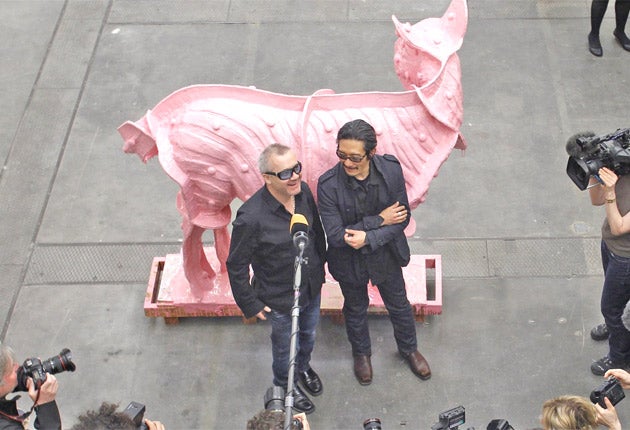Drinking partners make an exhibition of themselves

Your support helps us to tell the story
From reproductive rights to climate change to Big Tech, The Independent is on the ground when the story is developing. Whether it's investigating the financials of Elon Musk's pro-Trump PAC or producing our latest documentary, 'The A Word', which shines a light on the American women fighting for reproductive rights, we know how important it is to parse out the facts from the messaging.
At such a critical moment in US history, we need reporters on the ground. Your donation allows us to keep sending journalists to speak to both sides of the story.
The Independent is trusted by Americans across the entire political spectrum. And unlike many other quality news outlets, we choose not to lock Americans out of our reporting and analysis with paywalls. We believe quality journalism should be available to everyone, paid for by those who can afford it.
Your support makes all the difference.Their friendship was formed as they stood facing each other, hammers in hand, hanging up their respective works of art in a shared gallery space two decades ago.
The unlikely bond between Damien Hirst, Britain's highest-earning living artist, and Michael Joo, his lesser-known American-Korean counterpart – who at first may appear to have little in common – has blossomed over the years. The pair share a love of 1970s punk rock, friendly competition on the pool table, and a predilection for "cutting things up" – including sharks and cows, on Hirst's part.
Now, they have made the step from drinking partners to professional equals as they have opened their first joint exhibition together, Have You Ever Really Looked at the Sun?, which is on show at the Haunch of Venison gallery in Berlin until 14 August.
The pair's friendship began in 1991 as they prepared their booths at the Unfair exhibition in Cologne, Germany. Hirst has helped Joo with his career before, including him in the exhibition Some Went Mad, Some Ran Away at London's Serpentine Gallery in 1994, which first brought the Korean's work to international attention.
By then, Hirst was already one of the most powerful artists in Britain, standing at the vanguard of the Young British Artists movement and commanding massive sums for a single work of his art.
Speaking to The Independent yesterday, Joo, who has since had numerous solo shows and has seen his profile rise accordingly, said he and Hirst both shared "a lot of common interests".
"I grew up in a blue-collar environment, which was rural, but it was also a very working-class neighbourhood, like Damien Hirst's [in Leeds]," he said. "Many things added to the stew, but there was something in our upbringing, and art comes from life."
The two artists are planning a show based around their shared fascination of the natural world, which was reflected in a recent exhibition in Berlin in which both displayed their works – including Hirst's fly-infested installation Let's Eat Outdoors Today (which was reanimated with freshly hatched flies imported from Britain) and Joo's reconstructed oak and stainless steel trunk.
A second-generation Korean-American, Michael Joo was born in 1966 in Ithaca, New York, a year after Hirst was born in Bristol. Unlike Hirst, who found his vocation early and rose to fame while still a student at Goldsmiths in London, Joo studied biology at Wesleyan University and worked for a seed science company before turning to sculpture in 1989.
Joo has had 14 solo exhibitions in galleries and museums around the world and has also been shown at White Cube gallery in London, which has represented Hirst for years. Joo also represented South Korea in the 2001 Venice Biennale.
Since Hirst's endorsement of his work at the Serpentine Gallery in 1994, he has become a leading contemporary conceptual artist who frequently uses animal forms in his work, from moose antlers to zebra skin.
Joo conceded that his work shared similarities with Hirst's, but added that there was always an "ongoing dialogue" between artists of the same generation, with "one artist riffing off another".
Referring to Hirst's most famous installations, which feature sharks, sheep and cows cut in half and immersed in formaldehyde, Joo added: "Like Damien, I like to look more deeply into things and see what it's all about. I want to look at the core, but as with the title of the show, you can never really look at the core. You can feel the heat, look at the light, but you can't look at the Sun."
Hirst reportedly said he shared many points of professional interest with Joo: "We're both interested in science. Nature. Minimalism. Love. Jesus. Though the jury's still out on God... for me."
Join our commenting forum
Join thought-provoking conversations, follow other Independent readers and see their replies
Comments